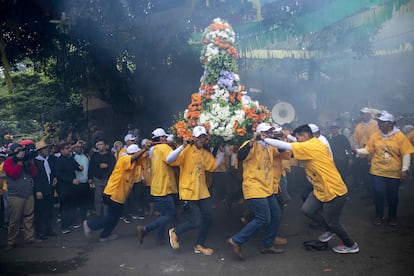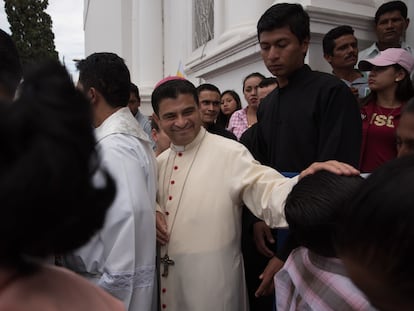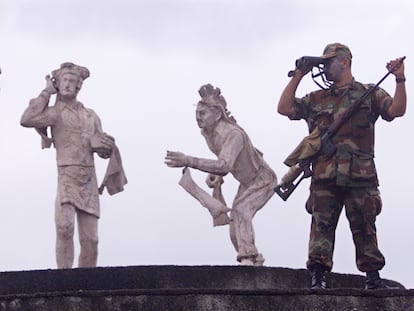Dances, bullfights, processions: Ortega masks persecution of Catholic Church behind ‘traditional and religious’ festivities
Nicaragua’s presidential couple, Daniel Ortega and Rosario Murillo, is promoting feast-day celebrations across the country while repression against Catholicism continues apace

Photos of Nicaraguan cardinal Leopoldo Brenes welcoming the Sandinista mayor of Managua, Reyna Rueda, to Las Sierritas parish have sparked controversy in Central America’s largest country. The photos show the Catholic prelate smiling and conversing with functionaries from the government of Daniel Ortega and Rosario Murillo, a regime that continues to pursue a fierce campaign of religious persecution against Catholicism. The mayor and the priest had convened to celebrate the Feast of Santo Domingo de Guzmán (Saint Dominic de Guzman), Managua’s patron saint, venerated every August in one of the most well-attended and passionate religious festivals in the country.
In 2018, after the outbreak of nation-wide protests and the campaign of brutal state repressed that followed, the Catholic Church stopped granting Managua’s mayors the privilege of presiding over the annual celebration as mayordomos de Santo Domingo. While neither Mayor Rueda nor Vice Mayor Enrique Armas were allowed to serve as mayordomos this year either, their mere presence at Las Sierritas Church, which was widely publicized across official media channels, was nonetheless surprising. In the months since Semana Santa, the Catholic Holy Week celebrated every April, the Sandinista regime has denied thousands of permits for various church-related events, but in recent weeks, the government has apparently reversed course, allowing certain religious and traditional processions to take place in the country.
But the lifting of the ban has been selective and partial. In towns and cities across Nicaragua, the Ortega-Murillo regime has allowed dances, bull running, horse riding and other “traditional” activities held as part of each community’s patron saint festivities, but the government has denied permission for some devotional processions, such as those held in honor of Saints Santa Ana and San Joaquín in the communities of Nandaime and Chinandega. But this year, for the first time since 2018, the regime allowed Managua’s historic procession for the Feast of Santo Domingo, which prior to the ban would descend from the mountains to the eastern neighborhoods of Nicaragua’s capital city every August. The event is not only a religious tradition, but a media spectacle as well, and the presidential couple, according to researcher Martha Patricia Molina, author of the study Nicaragua, una Iglesia Perseguida [Nicaragua: A Persecuted Church], has decided to take full advantage of it.
“The Santo Domingo processions — and I’m sure this is true for the La Merced festivities taking place next month in León as well — have been permitted for cultural and touristic reasons, not because the Sandinistas are suddenly religious,” Molina says. “Then they bring in the police and city officials to send a message to the rest of the country that there is no religious persecution in Nicaragua. Meanwhile, there are standing orders to expel foreign religious leaders from the country.”
Speaking to EL PAÍS, Molina argued that all processions and religious expressions should be allowed without restriction, because “they are a constitutional and human right.” But, she says, “the dictatorship has already banned more than 3,200 processions in 2023, because the government sees these activities as having the potential to turn into protests, and because they hate everything religious. It’s an act of revenge against the Catholic community.”
Persecution continues
The Sandinista government maintains an open investigation into the Catholic Church, including against Cardinal Brenes himself, for alleged money laundering. Five priests are currently imprisoned in Nicaragua, and three others are “under investigation.” Bishop Rolando Álvarez has been in custody since August 2022, and was sentenced to 26 years in prison this February after he refused to join 222 of his fellow political prisoners who were freed and sent into exile in the United States.
Less than a month ago, the presidential couple revoked the legal status of the Fundación Fraternidad Pobres de Jesucristo, a religious nonprofit dedicated to serving the country’s poor through the provision of food, clothing and prayers. The government then ordered the expropriation of the institution’s assets. The nuns of the fraternity were immediately forced to leave Nicaragua, and fled to nearby El Salvador. Meanwhile, five days ago, Nicaragua’s General Directorate of Migration and Foreign Affairs (DGME) cancelled the residency of the Italian friar Domingo Pepe, who was also expelled from the country.
“Despite the fact that this August 1st, as we speak, Managua is enjoying the dancing, laughter and fireworks typical of the Santo Domingo festivities, the repression against the Church continues,” Molina says. The procession in Managua last week may not have been as large as it was in years prior to 2018, but that did not stop several thousand people from accompanying the pilgrimage in a carnivalesque explosion of dancing and drinking.
Rosario Murillo: “A pilgrimage of joy”
In the midst of this repressive context, Ortega’s “co-president,” Rosario Murillo, announced last Friday that a series of “traditional and religious” festivities would be held across the country, including for the Feast of Santo Domingo in Managua, and the Feast of Santa Ana in Chinandega, Nindirí and Niquinohomo. In addition, Murillo said that the Feast of Santiago (Saint James) would be celebrated in the communities of Boaco, Nagarote, Santo Tomás, Jinotega, Sébaco and Somoto. Murillo boasted that, as part of this “great celebration,” Nicaragua would enjoy a total of 13 bullfights as well as numerous horse races and other equestrian events.
“Here, from one feast to the next, grateful to God, celebrating peace. Because peace is our victory... Celebrating life, celebrating love and kindness, celebrating brotherhood and solidarity, celebrating our cultural identity,” Murillo said during her daily address, after listing the activities the government was promoting, which would include rodeos, bull rides, and the traditional Palo Lucio festival in Managua.
Cardinal Brenes has not said a word about his meeting with Sandinista officials in Managua, but a few days ago, the parish priest of Las Sierritas Church, Boanerges Carballo, said that the Feast of Santo Domingo had been possible this August “thanks to the ability to have dialogue.” In 2017, the Ortega-Murillo regime appointed Carballo’s sister, Esther Margarita Carballo, as Nicaragua’s ambassador to The Vatican. In the eighties, the priest’s other sibling and another important religious leader in the country, Monsignor Bismarck Carballo, was the victim of a Sandinista government intelligence operation, but in 2004, he “reconciled” with the regime and has been close to the presidential couple ever since.
On August 1, Murillo presided over the Santo Domingo celebrations in Managua, as the tiny saint descended from the mountains on the shoulders of his devoted pilgrims: “Today we celebrate with joy our traditional festivities, this pilgrimage of joy, this dance, the dance that cries out, that beseeches, that we devote to the saint of all Managuans, the dance that asks, as always, for peace and wellbeing. Because peace is our victory, peace is what our work, and our stability, depend on. Peace is what our prosperity depends on,” announced the co-president, who together with her husband is accused of committing crimes against humanity.
Sign up for our weekly newsletter to get more English-language news coverage from EL PAÍS USA Edition
Tu suscripción se está usando en otro dispositivo
¿Quieres añadir otro usuario a tu suscripción?
Si continúas leyendo en este dispositivo, no se podrá leer en el otro.
FlechaTu suscripción se está usando en otro dispositivo y solo puedes acceder a EL PAÍS desde un dispositivo a la vez.
Si quieres compartir tu cuenta, cambia tu suscripción a la modalidad Premium, así podrás añadir otro usuario. Cada uno accederá con su propia cuenta de email, lo que os permitirá personalizar vuestra experiencia en EL PAÍS.
¿Tienes una suscripción de empresa? Accede aquí para contratar más cuentas.
En el caso de no saber quién está usando tu cuenta, te recomendamos cambiar tu contraseña aquí.
Si decides continuar compartiendo tu cuenta, este mensaje se mostrará en tu dispositivo y en el de la otra persona que está usando tu cuenta de forma indefinida, afectando a tu experiencia de lectura. Puedes consultar aquí los términos y condiciones de la suscripción digital.
More information
Archived In
Últimas noticias
Most viewed
- Oona Chaplin: ‘I told James Cameron that I was living in a treehouse and starting a permaculture project with a friend’
- Reinhard Genzel, Nobel laureate in physics: ‘One-minute videos will never give you the truth’
- Sinaloa Cartel war is taking its toll on Los Chapitos
- Why the price of coffee has skyrocketed: from Brazilian plantations to specialty coffee houses
- Silver prices are going crazy: This is what’s fueling the rally











































